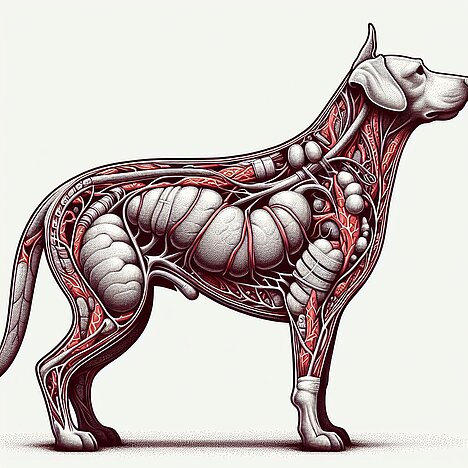Amyloidosis

Amyloidosis is a disease in which a waxy, fibrous substance made of protein called amyloid builds up in your dog's organs and tissues and impairs their function. If amyloidosis is not detected and treated early enough, it can lead to organ failure. In this article you will learn more about the causes, symptoms, diagnosis and treatment of this disease.
What are the causes of amyloidosis?
There are four forms of amyloidosis, which differ according to the history and location of the deposit:
- Primary amyloidosis: it occurs suddenly, with no known history of another disease. The cause is usually a genetic mutation that promotes the formation of abnormal proteins.
- Familial amyloidosis: It is genetically determined and occurs in combination with certain hereditary diseases. It mainly affects certain dog breeds such as Beagle, Pointer, Shar-Pei, English Foxhound, Akita Inu and Collie.
- Secondary amyloidosis: It occurs as a result of chronic inflammation or infection that increases the production of inflammatory proteins. Possible triggers include diabetes mellitus, chronic renal insufficiency, liver inflammation or bacterial endocarditis (inflammation of the heart valve).
- Age-related amyloidosis: This develops in older dogs without the presence of any other disease. It is probably due to a natural breakdown of proteins with age.
In most dogs, the kidney is affected, although the Shar-Pei is more prone to protein deposits in the liver.
What are the symptoms of amyloidosis?
The symptoms of amyloidosis depend on which organs are affected and how badly they are damaged. The most common signs include
- Pale mucous membranes
- Yellow discolored mucous membranes due to the storage of bile pigments (in the case of liver disease)
- Increased thirst
- Increased urine output
- Dehydration
- Vomiting
- Diarrhea
- Abdominal pain
- Loss of appetite
- fever
- Swollen joints
- Joint pain
- Weakness
The symptoms can occur gradually or suddenly and vary in severity.
How is amyloidosis diagnosed?
The diagnosis of amyloidosis is often difficult as the symptoms are non-specific and may also indicate other diseases. The veterinarian will perform a thorough physical examination and order various tests to determine the cause. These include:
- Blood work: a complete blood count, biochemical parameters and a coagulation profile may indicate anemia, liver or kidney dysfunction or inflammation.
- Urinalysis: A urine sample can indicate proteinuria (protein in the urine), hematuria (blood in the urine) or bacteriuria (bacteria in the urine).
- X-ray: An X-ray can show changes in the size or shape of the organs.
- Ultrasound : An ultrasound examination can show the structure and blood flow of the organs and detect possible deposits.
- Genetic test: In the familial form of amyloidosis, a genetic test can detect the genetic mutation.
Amyloidosis is usually only diagnosed at an advanced stage of the disease, when the organs are already severely damaged.
How is amyloidosis treated?
The treatment of amyloidosis depends on the underlying cause and the organ affected. A cure is not possible, but symptomatic therapy can improve your dog's quality of life and slow down the progression of the disease. Possible measures include
- Change of diet: a special diet tailored to your dog's needs can reduce the stress on the organs and cover the nutritional requirements. Depending on the case, a low-protein, low-fat, low-carbohydrate or low-sodium diet may be recommended.
- Medication: Various medications can be used to relieve symptoms and support organ function. These include anti-inflammatory, analgesic, antihypertensive, diuretic, antibacterial or anticoagulant agents.
- Blood transfusion: In the event of bleeding in the abdominal cavity or severe anemia, a blood transfusion may be necessary to compensate for the blood loss.
- Surgery: In rare cases, surgery may be considered to remove part or all of the affected organ.
Treatment requires regular monitoring and adjustment by the vet. The prognosis depends on the stage and extent of the disease.
How can amyloidosis be prevented?
Amyloidosis is a serious and often fatal disease that is not always preventable. However, there are some steps you can take to reduce the risk or at least intervene early:
- Breeding: Dogs that have been diagnosed with amyloidosis or have a genetic predisposition to it should not be used for breeding. If you have a dog from an at-risk breed, you should find out about its ancestry and have a genetic test carried out.
- Prevention: You should have your dog examined regularly by a vet and look out for possible symptoms. Early diagnosis can improve the chances of treatment and reduce your dog's suffering.
- Health: You should feed your dog a healthy diet, provide it with sufficient exercise and protect it from infections. A good immune system and a stable metabolism can prevent or delay the development of inflammation and deposits.
Amyloidosis is a serious disease that can threaten your dog's life. This article will give you more information about this disease and how you can recognize and treat it.
The authors assume that a veterinarian should be consulted if an animal is ill and that medication should only be taken after consultation with a doctor or pharmacist. Only an individual examination can lead to a diagnosis and treatment decision.
We help you find the nearest vet → This way